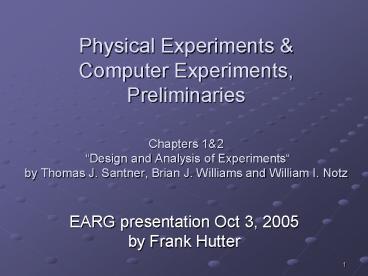Physical Experiments - PowerPoint PPT Presentation
Title:
Physical Experiments
Description:
Physical Experiments & Computer Experiments, Preliminaries Chapters 1&2 Design and Analysis of Experiments by Thomas J. Santner, Brian J. Williams and William I ... – PowerPoint PPT presentation
Number of Views:47
Avg rating:3.0/5.0
Title: Physical Experiments
1
Physical Experiments Computer
Experiments,PreliminariesChapters 12 Design
and Analysis of Experimentsby Thomas J.
Santner, Brian J. Williams and William I. Notz
- EARG presentation Oct 3, 2005by Frank Hutter
2
Preface
- What they mean by Computer Experiments
- Code that serves as a proxy for physical process
- Can modify inputs and observe how process output
is affedcted - Math
- Should be understandable with a Masters level
training of Statistics
3
Overview of the book
- Chapter 1 intro, application domains
- Chapter 2
- Research goals for various types of inputs
(random, controlled, model parameters) - Lots of definitions, Gaussian processes
- Chapters 3-4 Predicting Output from Computer
Experiments - Chapter 5 Basic Experimental Design (similar to
last term) - Chapter 6 Active Learning (sequential
experimental design) - Chapter 7 Sensitivity analysis
- Appendix C code
4
Physical experiments a few concepts we saw last
term (2f)
- Randomization
- In order to prevent unrecognized nuisance
variables from systematically affecting response - Blocking
- Deals with recognized nuisance variables
- Group experimental units into homogeneous groups
- Replication
- Reduce unavoidable measurement variation
- Computer experiments
- Deterministic outputs
- None of the traditional principles ... are of
use
5
Types of input variables (15f)
- Control variables xc
- Can be set by experimenter / engineer
- Engineering variables, manufactoring variables
- Environmental variables Xe
- Depend on the environment/user
- Random variables with known or unknown
distribution - When known for a particular problem xe
- Noise variables
- Model variables xm
- Parameters of the computer model that need to be
set to get the best approximation of the physical
process - Model parameters, tuning parameters
6
Examples of Computer Models (6ff)
- ASET (Available Safe Egress Time)
- 5 inputs, 2 outputs
- Design of Prosthesis Devices
- 3 environment variables, 2 control variables
- 2 competing outputs
- Formation of Pockets in Sheet Metal
- 6 control variables, 1 output
- Other examples
- Optimally shaping helicopter blade 31 control
variables - Public policy making greenhouse gases 30 input
variables, some of them modifiable (control
variables)
7
ASET (Available Safe Egress Time) (4f)
- Evolution of fires in enclosed areas
- Inputs
- Room ceiling height and room area
- Height of burning object
- Heat loss fraction for the room (depends on
insulation) - Material-specific heat release rate
- Maximum time for simulation (!)
- Outputs
- Temperature of the hot smoke layer
- Distance of hot smoke layer from fire source
8
Design of Prosthesis Devices (6f)
- 2 control variables
- b, the length of the bullet tip
- d, the midstem parameter
- 3 environment variables
- ?, the joint angle
- E, the elastic modulus of the surrounding
cancellous bone - Implant-bone interface friction
- 2 conflicting outputs
- Femoral stress shielding
- Implant toggling
- (flexible prostheses minimize stress, but toggle
more ? loosen)
9
Formation of Pockets in Steel (8ff)
- 6 control variables
- Length l
- Width w
- Fillet radius f
- Clearance c
- Punch plan view radius p
- Lock bead distance d
- Output
- Failure depth (depth at which the metal tears)
10
Research goals for homogeneous-input codes (17f)
- Homogeneous-input only one of the three possible
variable types present - All control variables xxc
- Predict y(x) well for all x in some domain X
- Global perspective
- Integrated squared error sX y(x) - y(x)2 w(x)
dx - Cant be computed since y(x) unknown, but in
Chapter 6 well replace y(x)-y(x)2 by a
computable posterior mean squared value - Local perspective
- Level set Find x such that y(x) t0
- t0 maximum value
11
All environmental variables xXe (18)
- How does the variability in Xe transmit through
the computer code ? - Find the distribution of y(Xe)
- When the problem is to find the mean
- Latin hypercube designs for choosing the training
sites
12
All model variables xxm (18f)
- Mathematical modelling contains unknown
parameters (unknown rates or physical constants) - Calibration (parameter fitting)
- Choose the model variables xm so that the
computer output best matches the output from the
physical experiment
13
Research goals for mixed inputs (19ff)
- Focus on case with control and environmental
variables x(xc,Xe) where Xe has a known
distribution - Example hip prosthesis
- y(xc,Xe) is a random variable whose distribution
is induced by Xe - Mean ?(xc) Ey(xc,Xe)
- Upper alpha quantile ?? ??(xc)
- Py(xc,Xe) gt ?? ?
14
Research goals for mixed inputssimple adaption
of previous goals (20ff)
- Predict y well over its domain
- Minimize sX ?(x) - ?(x)2 w(x) dx
- (again, there is a Bayesian analog with
computable mean) - Maximize the mean output maxxc ?(xc)
15
When the distribution of Xe is unknown
- Various flavours of robustness
- G-robust minimax
- Want to minimize your maximal loss
- Pessimistic
- ?(.)-robust
- Minimize weighted loss (weighted by prior density
on distribution over Xe) - M-robust
- Suppose for a given xc, y(xc,xe) is fairly flat
- Then value of Xe doesnt matter so much for that
xc - Maximize ?(xc) subject to constraints on variance
w.r.t. Xe































